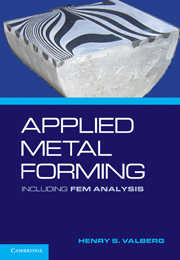Book contents
- Frontmatter
- Contents
- Preface
- APPLIED METAL FORMING
- 1 Characteristics of Metal Forming
- 2 Important Metal Forming Processes
- 3 FEA of Metal Forming
- 4 Theory
- 5 Reduction and Proportions of the Plastic Zone
- 6 Deformations from the Velocity Field
- 7 Technological Tests and Physical Simulation
- 8 Flow Stress Data
- 9 Formability and Workability
- 10 Friction and Friction Models
- 11 Thermal Effects
- 12 Experimental Metal Flow Analysis
- 13 Theoretical Methods of Analysis
- 14 Finite Element Analysis
- 15 FEA of Technological Tests
- 16 Forging
- 17 FEA of Forging
- 18 Extrusion
- 19 FEA of Extrusion
- 20 Rolling
- 21 FEA of Rolling
- 22 Drawing of Wire, Profiles, and Tubes
- 23 FEA of Wiredrawing
- 24 Sheet-Metal Forming
- Index
- References
11 - Thermal Effects
Published online by Cambridge University Press: 05 June 2012
- Frontmatter
- Contents
- Preface
- APPLIED METAL FORMING
- 1 Characteristics of Metal Forming
- 2 Important Metal Forming Processes
- 3 FEA of Metal Forming
- 4 Theory
- 5 Reduction and Proportions of the Plastic Zone
- 6 Deformations from the Velocity Field
- 7 Technological Tests and Physical Simulation
- 8 Flow Stress Data
- 9 Formability and Workability
- 10 Friction and Friction Models
- 11 Thermal Effects
- 12 Experimental Metal Flow Analysis
- 13 Theoretical Methods of Analysis
- 14 Finite Element Analysis
- 15 FEA of Technological Tests
- 16 Forging
- 17 FEA of Forging
- 18 Extrusion
- 19 FEA of Extrusion
- 20 Rolling
- 21 FEA of Rolling
- 22 Drawing of Wire, Profiles, and Tubes
- 23 FEA of Wiredrawing
- 24 Sheet-Metal Forming
- Index
- References
Summary
The energy consumed in a metal forming operation, as, for instance, in a forging stroke, is mainly transformed into heat, which leads to temperature rise in the die and the workpiece. In heavy metal forming equipment, a lot of energy is supplied to the workpiece this way, and there can be substantial global and local heating effects in the workpiece material.
In many metal forming applications, there are limits on how high the temperature of the workpiece can rise before one experiences problems such as reduced or unacceptable product quality. This is, for instance, the case in aluminum extrusion, where the maximum temperature of the metal near the outlet from the die should not exceed a certain critical temperature. In this process, material defects, such as surface cracking due to hot tearing of the material, start to appear when this critical temperature is exceeded, and a usable profile can no longer be manufactured. This phenomenon is explained and discussed in this chapter.
In addition, it is shown how one can quantify different thermal effects in a metal forming process, such as heating due to plastic deformation inside the workpiece, and heating due to friction over its surface. When the workpiece has higher temperature than the dies, there is cooling against the dies, and the physics required to calculate the cooling is shown for a simple two-dimensional case.
- Type
- Chapter
- Information
- Applied Metal FormingIncluding FEM Analysis, pp. 159 - 180Publisher: Cambridge University PressPrint publication year: 2010



